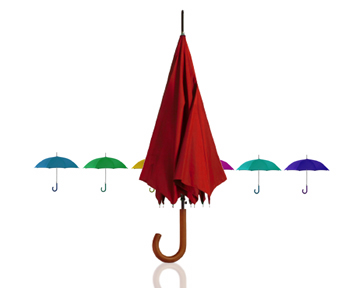
My umbrella is in my car and it’s raining outside. I am
sitting here at my computer trying to make a deadline. I have to leave in just
a minute and I can hear the rain pounding down on the roof of the building,
with the wind kicking it against the window pane beside my desk, and my
stinking umbrella is sitting in the back of my vehicle! It is just my luck!
Actually, luck has little to do with the reason I don’t have
my umbrella when I most need it. The fact is, I made a critical mistake when I
came into work today. Oh, I knew rain was in the forecast. I have a dashboard
on my computer that tells me what the current weather conditions are and keeps
a five-day forecast in front of me all the time. I read the newspaper before I
came into work. I listened to the forecast on the radio. I had enough information;
I just failed to heed all of this information and actually bring my umbrella
into the office. You see, 90 percent of the time, I don’t need my umbrella, so
it is not in my routine to bring it with me. You can call it being stuck in my
own little rut.
Now let me relate my current dilemma with the way I see
companies market themselves. They may have all of the right tools; they just
have not thought ahead enough to know when to use them until it is too late.
Movie critic Leonard Maltin once said "Timing in life is everything.” This is
certainly true of marketing. There is a right time and a wrong time to move
ahead with a marketing campaign.
So how far ahead should you be planning? When do you know
when to go and when to stop? A lot of that depends upon your target market and
their buying habits. Here is a fairly simple marketing exercise to do.
1. Take a
look at your sales figures for the past few years. When did your customers
do most of their purchasing with you? Was it a particular season or a
month of the year?
2. Were
there some special conditions that made them purchase when they did? Was
there a shortage of a product that caused them to purchase to ensure they
had an inventory? An example would be rock salt to thaw ice when there is
an elongated winter with several snow events. Was there something
unsettling that happened in the marketplace that impacted their decision
to buy from you? For instance, did they put off buying until the last part
of their fiscal year when they knew they had dollars left in the budget to
make a purchase?
3. Take
the time of the year for the purchases and compare it to the conditions
under which they made the purchase. It is the convergence of the special
condition and the season of the year when purchases are typically made
that creates the perfect environment for a sale. From this information,
write a simple equation.
When (the special condition) happens in (the season in which
they purchased), I must have
completed my marketing campaign and be ready to deliver the customer to sales.
Work backwards from your equation. Typically, 4-6 months out
you should be working on your marketing campaign and fine tuning it for
function. (Christmas marketing is typically planned and made ready by the
Fourth of July.) Begin your campaign with awareness marketing. This should be
in front of the customer before they cycle into buying mode. It needs to be
repetitive. If you have a campaign slogan, keep it in front of the customer
until they can’t help but notice it. You want them to remember who you are.
Awareness marketing supports first time sales marketing materials. These are
the marketing tools that your sales staff needs to convince the client to make
the purchase. What will it take to help your client make a decision for you?
This material needs to be in front of the customer at the beginning of the
purchasing cycle. Get your retention campaigns in place to keep old customers
coming back after that first sale. What are you offering someone who has
already made a purchase with you? This also needs to be in the hands of the
customer at the beginning of the purchasing cycle. As you gain new clients,
think of the next logical buy that they will make. It may be to broaden the
services they purchase from you. It may be to purchase an accessory that
complements the item they originally purchased from you. Give them a reason to
come back to you within the time frame of the purchasing cycle.
For many companies, purchasing cycles are very clearly
defined. It could be when trade shows happen. It could be when the weather is
good. There is nothing more frustrating than missing this window of opportunity
or coming into the purchasing cycle late. If you want to ensure you are getting
the most out of your marketing efforts, make sure your tools are ready to go
when you need them the most.
____________________________________
Leonard
Maltin quote, Brainy Quotes
http://www.brainyquote.com/quotes/quotes/l/leonardmal225934.html